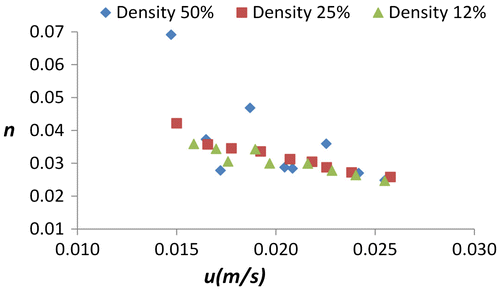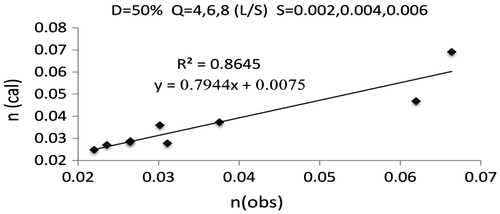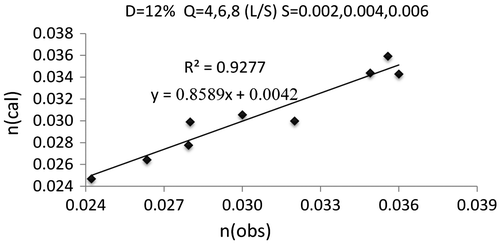Abstract
The roughness coefficient is function of physical characteristics of flow, such as water depth, velocity, type and density of vegetation coverage. Impact assessment of vegetation coverage on flow roughness coefficient and trapping of sediment in experimental condition were the research aims. The research tests were conducted in different water discharge, various slope of substrate and three density of coverage using physical model. Relations for estimation of the Manning’s coefficient were developed using statistical analysis. The best performance of model in estimation of the flow roughness was gained at 12% density of coverage and steady injection of sediments.
Introduction
There is longtime that riverine hydraulic features have been studied by researchers (Ciraolo, Ferreri, & Loggia, Citation2006; Cook, Citation1938; Cox & Palmer, Citation1948). Further, river engineers have widely used hydraulic equations to gain the best design for river structures. Importance of hydraulic phenomenon in arid and semi-arid regions because of water shortage and need to gain maximum efficiency has been strengthened. Notable application of this knowledge has been confirmed to solve environmental issues, such as river bank erosion and sediment transport. Besides, expectation of hydraulic behaviour of rivers and agricultural water channels which are facing to different cultivation patterns is known issue between river engineers. Identify of such problems will result in gaining effective and economic patterns of cultivation and mitigation of flood risks. Nezo and Naot (Citation1999) have introduced a model to assess impact of vegetation coverage on the flow turbulence at rectangular cross sections along the physical flume. They find out that highest turbulence energy was at toe of vegetation coverage. Balochi and Shafai-Bajestan (Citation2012) have studied effects of sediment input from a stream into main waterway at junction point using physical model. They found that downstream of junction point were eroded because of variation in rate of water and sediment discharge. Thus, destructive effects on downstream river structures and changes in river morphology will be expected. They also developed relevant relations for estimation of scouring depth in steady sediment transport condition. Sharp and James (Citation2005) have studied trapping of sediments at different density of vegetation converges at two physical flumes. They found that trapping of sediment will be increased by rising of water level and density of stems.
Ebrahimi (Citation2008) has developed new method for estimation of the flow roughness using artificial vegetation at physical flume with variable substrate. The research variables were the water discharge, type and density of vegetation and the bed slope. He stated that increase in density of artificial vegetation has resulted in increase of the flow roughness. Reversely, rising in water level and velocity of flow have led to low values of the Manning’s coefficient. Mathematical model was set to estimate water level during experiments. Results showed that this model will expect water level at a river using different roughness coefficients.
Impact assessment of growing vegetation on the river flow roughness was done by (Curran & Hession, Citation2013) at University of Virginia. He found how vegetation coverage affects the dynamics of sediments. The riverbed roughness affects water level, sediment transport, and morphology of the river. Stems with cylindrical shapes and natural grasses were used as vegetation coverage during tests.
Aliza, Tjahjanto, Ali, Shaylinda, and Asyraff (Citation2009) have studied effects of vegetation coverage on roughness coefficient of open channels. As a result, they have reached a linear relation between roughness coefficient and water depth. Similar research was performed by (Fengfeng, Lin, & Dingman, Citation2011) at hydraulic laboratory of Dalian University. They have used reeds as vegetation coverage which was natural obstacles at Chang River. Reeds have been introduced by several researchers as source of flow resistance. Therefore, such capability of reeds has provided an applied tool for management of natural waterways and river mouths.
Mir-Sadeghi (Citation2014) have studied effects of grain size of bed materials on flow characteristics and vegetation coverage using physical flume. The flume was composed of transparent walls, 9 m long, 0.4 m width, 0.7 m height, and changeable bed slope. Results showed that larger grain size was resulted in increased roughness coefficients and lower velocity of currents. He also stated that turbulence was occurred at separation points of flow. Meanwhile, turbulence of flow was dramatically increased by rapid changes in grain size of bed materials.
Nehal, Hamimed, and Khaldi (Citation2013) has investigated effects of submerged vegetation on physical properties of flow. Drowned vegetation has resulted in increasing of water level and the Manning’s coefficient was remarkably enhanced. Similar study was carried out by (Xia & Nehal, Citation2013) using Acorus Calamus species at coastal zone. He found that parts of stem and foliage of this species showed different effects on hydrological properties of flow. Manning’s coefficient was increased by increase of relation of water depth and height of stem (h/hs). The mean velocity of flow at foliage part was less than the velocity at stem of plant.
Condition and terms of river flow with submerged vegetation at banks and the riverbed have studied by (Bo, Hsun-Chuan, & You-Cheng, Citation2014). They stated that drowned vegetation have played important role in decreasing of flow velocity at riverbanks. Further, an increased in the flow velocity and depth of scouring hole was observed along the river centre.
The research aim was designated based on gap in knowledge, where assessment of vegetation coverage impacts on the Manning’s coefficient have not been studied in various concentration of sediment and slope of the substrate.
Materials and methods
The research methods were chosen to identify effective factors on the Manning’s coefficient. Ability of vegetation coverage in sediment trapping and gaining the best relation for estimation of the flow roughness was tested using the physical model. Reviewed literatures have extracted several effective factors that are showed at Table . A relation between such parameters was formulated in Equation (Equation1(1) ).
(1)
Table 1. Showing effective factors on the Manning’s coefficient and trapping of sediments.
Dimensional analyses were implemented for developing relations between effective agents and dimensionless parameters. The research method has not considered effects of surface tension forces and water viscosity because we assumed that these parameters have slightly affected in open physical flume. Therefore, effects of Reynolds number and Veber value was ignored. On the other hand, for sub-critical flow conditions also, influence the slope of the flume was ignored.
Equation (Equation2(2) ) was obtained by dimensional analysis using Buckingham method. Therefore, three main factors of velocity of flow (u), water depth (yn), and density of water (ρ) were assumed as time, length, and weight units, respectively.
(2)
where Fr and Re were Froude and Reynolds numbers, is ratio of mean velocity on shear velocity,
is ratio of length of vegetation on water depth,
is ratio of space interval of vegetation on depth of water,
is ratio of vegetation height on water depth, and
is shear Reynolds.
Steady state of flow velocity and subcritical condition in channels is dependent to Froude number. There is not significant positive correlation between Reynolds number and turbulent currents in channels with vegetation coverage. Therefore, the most effective parameters were identified as ,
, vegetation density, respectively.
The flume setup
The flume setup was designated based on measurements and condition of the tests. Therefore, the flume scale was estimated based on dimensionless limits and ability of equipment for providing proper water discharge. Two important preconditions for the flume setup were ability of the flume substrate for changing of slope and injection of sediments during tests. Accordingly, the flume was made using transparent walls (Plexiglas), with 10 m length and 0.25 m width. Further, pattern of vegetation coverage for installation at flume were included bunches of plastic trees with 400 cm−2 area, 7 cm height, and 2 cm space between each plant (Figure ). The sediment injection equipment and Triangular weir also were made based on the tests conditions.
The tests conditions
The tests conditions were defined based on sediment concentration, velocity of flow, water depth, vegetation density, and slope of substrate, respectively. Therefore, impact of vegetation coverage on the Manning’s coefficient was studied in three conditions of water flow (4, 6, and 8 li.s−1). Simultaneously, the flume slope has changed in three statuses (0.002, 0.004, and 0.006) and three density of coverage (12, 25, and 50%). The water discharge was set by steady water pumping and measuring of output water from triangular weir.
The flume substrate was covered by sand particles (D50 = 1.9 mm). The test conditions were completed by steady injection of 400 g.s−1 of fine grained sediments (0.15 mm). In addition, the flow velocity, changes in morphology of substrate and rate of sediment loss were measured at five cross sections using the electromagnetic current metre (OSK 14077 model), the bottom profiler, and the sediment trap, respectively. Table , for instance, represents test conditions for the test condition with 50% density of vegetation coverage.
Table 2. Showing effects of 50% coverage of vegetation on the Manning’s coefficient.
The test analysis
Analysis of tests was carried out based on determination of the energy line. The exponential relation Equation (Equation3(3) ) was set in the Excel and Solver softwares to calculate the Manning’s coefficient.
(3)
where S is the substrate slope, R is the hydraulic radius, and α, β, and γ are exponents which were calculated by regression lines. The exponential relation was optimized by reducing the least mean square using Solver software. Such mathematical relations were gained based on correlation between observational and calculated results. To select the best mathematical equation, adequacy of models (Me), and dimensionless error (NEn) were used. The Me values defined between 0 to −∞, which the highest accuracy of model is assumed to be Me = 1. The NEn values indicate frequency of errors by “n” coefficient. Adequacy of regressive models was obtained by Equation (Equation4(4) ).
(4)
where n is number of observations, k mean is averages of observations, and ki is observation values. Besides, the predicted value (Pi) was calculated using six mathematical relations. Therefore, the highest adequacy was obtained for test condition with 50% of vegetation coverage and without injection of sediment. In contrast, the lowest adequacy was observed in the test condition with 25% of vegetation coverage without injection of sediment.
The dimensionless error (NEn) was calculated using Equation (Equation5(5) ).
(5)
where nm and nc are calculated and observed values of n, respectively.
Results and discussion
The tests results can be implemented at the real scale, is noticeable result of present research. Multiconditions of tests has resulted in various range of data which was evaluated by mathematical equations. As a result, relations, coefficient of determination and dimensionless error for the test conditions is presented at Table .
Table 3. Showing relations and coefficient of determinations in different test conditions.
According to NEn amounts, −0.002 and −5.31 have indicated the best and the worst relations for calculation of the Manning’s coefficient. Therefore, the most reliable relations for impact assessment of vegetation coverage on the roughness coefficient were obtained for the test condition with 12% density of vegetation. Besides, the test status was associated with steady injection of sediments. On the other hand, the highest coefficient of determination (0.99) was gained for flow without sediment injection and 12% density of vegetation coverage. Further, the lowest amount of the Manning’s coefficient was observed for test condition with 25% density of vegetation coverage.
Relations between calculated and observational values of the Manning’s coefficient in various statuses of vegetation coverage densities have been illustrated at Figures . Significant correlation (R2 = 0.927) between calculated and observational values was gained for test condition of 12% density of vegetation (Figure ). This result has considerably confirmed statistical results. Variations in the Manning’s coefficient against different values of flow velocity were plotted (Figure ). Present study has indicated the notable role of the Eddy flow in decrease of correlations.
Figure 5. Correlation between roughness coefficient and the flow velocity in different density of vegetation coverage.

Present research and previous studies (Curran & Hession, Citation2013; Sharp & James, Citation2005) have highlighted role of vegetation coverage in concentration of sediments, roughness coefficient, the flow regime, water depth and the channel morphology. The sediment behaviour against type and density of vegetation coverage in mountainous Alpine streams was studied by (Rey, Isselin-Nondedeu, & Bédécarrats, Citation2007). This study which was implemented at steep river channels also showed importance of vegetation coverage in trapping of sediments. Therefore, present study has simulated similar condition using of the variable flume bed. Although, most of previous works have evaluated role of vegetation coverage in trapping of sediments, while present study has successfully achieved the best relation for estimation of the Manning’s coefficient.
Conclusion
The research theories were tested to reach the research objectives. Accuracy of the flume design and its setup and the test conditions were clearly approved by resultant data. Statistical analysis has shown correlations between variables of the research. The lowest number of roughness with significant positive correlation of 0.81% between calculated and observational values was obtained for test status of 25% vegetation coverage density. Statistical analysis has been widely used to develop relations for estimation of the Manning’s coefficient. So, the best relation of the Manning’s coefficient was presented according to coefficient of determination, NEn and Me values. The best performance in sediment trapping was obtained in test status with 12% coverage density. The present research has successfully presented applied relations for estimation of the Manning’s coefficient in waterways, where sediment transport and various vegetation coverage were considered. Further, the article assumed to be practical guideline for decision-makers in river engineering. Application of artificial and natural plants based on densities of vegetation which have presented in current research, provides suitable guideline to choose suitable management practices. Recently, relevant environmental issues to the sediment dynamic have caused critical constraints in river structures. Therefore, resulting data of this study has confidently recommended mitigating destructive effects of these issues in natural and artificial waterways. Besides, application of vegetation coverage in river engineering brought benefits, such as areas for recreation and tourism.
Funding
This study is supported by Soil Conservation and Watershed Management Research Institute, Tehran, Iran (SCWMRI) [grant number 2-29-29-94110].
Disclosure statement
No potential conflict of interest was reported by the authors.
Acknowledgement
The author offers sincere gratitude to academic staff of SCWMI for their kind technical supports during the research tests.
References
- Aliza, N., Tjahjanto, D., Ali, Z. M., Shaylinda, N., & Asyraff, M. (2009). Laboratory study on effects of vegetations in the open channel hydraulic roughness (Pennisetum purpureum and ipomoea aquatica). In International Conference on Water Resources, ICWR. Kuala Lumpur: Universiti Tun Hussein Onn Malaysia (UTHM).
- Balouchi, B., & Shafai-Bajestan, M. (2012). Effect of sediment load from main canal on maximum scour depth at river confluence. Journal of Irrigation and Water Engineering, 5(1), 1–14.
- Bo, R. K., Hsun-Chuan, C., & You-Cheng, C. (2014). Influence of the bank vegetation on the river bed variations. Geophysical Research Abstracts, 16.
- Ciraolo, G., Ferreri, G. B., & Loggia, G. L. (2006). Flow resistance of Posidonia oceanica in shallow water. Journal of Hydraulic Research, 44, 189–202.10.1080/00221686.2006.9521675
- Cook, H. L. (1938). Spartanburg outdoor hydraulic laboratory. Journal of the Civil Engineering Division, 8, 653–655.
- Cox, M. B., & Palmer, V. J. (1948). Results of tests on vegetated waterways and method of field application. Oklahoma Agricultural Experiment Station. Miscellaneous publication no. MP-12, 43.
- Curran, J. C., & Hession, W. C. (2013). Vegetative impacts on hydraulics and sediment processes across the fluvial system. Journal of Hydrology, 505, 364–376.10.1016/j.jhydrol.2013.10.013
- Ebrahimi, N. G. (2008). Estimation of the vegetation roughness coefficient in bed river for mathematical models calibration, in River Engineering. Ahwaz: Shahid Chamran University.
- Fengfeng, G. U., Lin, M. U., Dingman, Q. I., Junhua, L. I., Lingshuang, K., & Yuanyang, W. (2011). Study on roughness coefficient for unsubmerged reed in the Changjiang Estuary. Acta Oceanologica Sinica, 30, 108–113.
- Mir-Sadeghi, F. (2014). Evaluation of hydraulic flow in channels with variable wall vegetation and aggregation on the floor, in River Engineering. Tehran: University of Tarbiat Modarress University.
- Nehal, L., Hamimed, A., Khaldi, A. (2013). Experimental study on the impact of emergent vegetation on flow. In A. Yousef (Ed.), 17th International Water Technology Conference, IWTC. Istanbul: Fatih University.
- Nezo, I., & Naot, D. (1999). Partly vegetated open channels, new experimental evidence. In 28th International IAHR Conference. Graz: IAHR.
- Rey, F., Isselin-Nondedeu, F., & Bédécarrats, A. (2007). Vegetation dynamics on sediment deposits upstream of bioengineering works in mountainous marly gullies in a Mediterranean climate (Southern Alps, France). In Stokes, A., Spanos, I., Norris, J. E., & Cammeraat, E. (Eds.), Eco-and ground bio-engineering: The use of vegetation to improve slope stability: Proceedings of the First International Conference on Eco-Engineering 13–17 September 2004 (pp. 297–307). Dordrecht: Springer.
- Sharpe, r. G., & Jame, C. S. (2005). Deposition of sediment from suspension in emergent vegetation. Water SA, 32, 221–228.
- Xia, J., & Nehal, L. (2013). Hydraulic features of flow through emergent bending aquatic vegetation in the Riparian zone. Water, 5, 2080–2093.10.3390/w5042080




